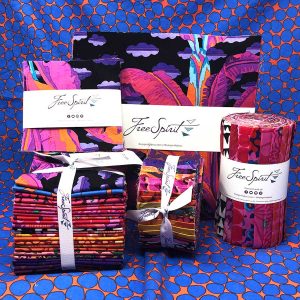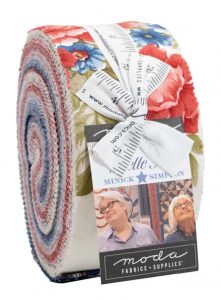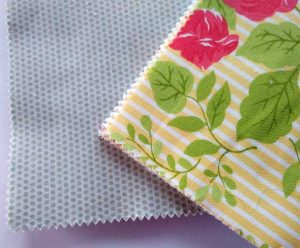If you’re a quilter, chances are you’re familiar with pre-cut fabric groupings, but if you’re not a quilter, the term may be new to you.
Pre-Cuts Explained

Most manufacturers offer their lines in coordinated groupings of various numbers of fabrics—often including prints, solids and perhaps dots or stripes that all go together. For those reticent about their own abilities to coordinate and mix patterns and colors, pre-cuts eliminate that stress, as they’re all planned to go together and there’s no decision making required.
Choosing a pre-cut bundle is a great way to sample a multitude of prints without having to purchase yardage of each fabric in the line—a huge cost saver. In addition, using pre-cuts saves time—not only for shopping, but also because you don’t have to cut all the pieces from yardage. Because they’re all cut at the same time, the pieces are all the same size.
Pre-cuts usually include one or two pieces for each fabric in the specific line and generally total twenty to forty-two pieces of the same size. The groupings can be made from a single fabric line or they can be chosen for other similarities, like all dots and stripes, all batiks, various prints in the same color range, or sometimes all neutrals.
Sizing

These handy time savers come in a variety of sizes and with a multitude of name variations, depending on the manufacturer. Look for monikers like Jelly Rolls, Charm Packs, Layer Cakes, Pops, Stackers, Roll-ups, etc. Most are quilting cottons, but there are also bundles of wools and other fabrics offered.
Common pre-cut sizes include strips of 1 ½”, 2 ½” or 5” by the width of the fabric. Squares come in 2”, 2 ½”, 5”, 6” and 10” variations. In addition, there are die-cut triangles, diamonds and hexagons available, and of course the more familiar fat quarter (18” x 22”) and fat eighth (9” x 22”) options.
During the manufacturing process, fabrics are layered and either die-cut, laser cut or manually cut into the preferred size/shape. The number of layers being cut at once is dependent on how many fabrics are in a given collection, and if there are multiples given of any.
 Many pre-cuts come with pinked edges to help prevent fraying {photo}, while others have straight-cut edges and may be plastic wrapped for the same reason. For those pre-cuts with pinked edges, use the peak to measure seam allowances, rather than the valley portion of the zigzag.
Many pre-cuts come with pinked edges to help prevent fraying {photo}, while others have straight-cut edges and may be plastic wrapped for the same reason. For those pre-cuts with pinked edges, use the peak to measure seam allowances, rather than the valley portion of the zigzag.
Using Pre-Cuts
Pre-cuts generally do not get pre-washed, as doing so can create a mess of lint and threads as pieces fray. But, if you compelled to do so, place them in a mesh bag and use a gentle cycle or simply place them in a basin of hot water to soak.
To help keep the edges of your fabric neater, use a lint roller along the edge of the pre-cuts before using.
There are many quilt patterns available that are specific to pre-cut sized pieces and they can also be used for all kinds of small projects where buying by the yard may not be necessary to cut the needed pieces. The 2 ½” x width-of-fabric strips are ideal for binding.
Measure the pre-cut pieces to be sure that they are accurately sized and if not, adjust pieces accordingly that you cut from yardage to pair with the pre-cuts. Some pre-cuts are actually larger than the stated size, while others may be slightly smaller.
And don’t forget—you can cut pre-cuts into small cuts if your pattern requires it. For example, a 10” pre-cut square can yield four 5” squares or sixteen 2 ½” squares, or some combination thereof.
Patterns
Sometimes a distinct pattern may not align with the cut edges on pre-cuts, causing the design to appear crooked. What can you do? If the issue is bothersome to you, think about recutting the piece along the design lines and using it as a smaller piece for another project.
~Linda Griepentrog
Linda is the owner of G Wiz Creative Services and she does writing, editing and designing for companies in the sewing, crafting and quilting industries. In addition, she escorts fabric shopping tours to Hong Kong. She lives at the Oregon Coast with her husband Keith, and two dogs, Yohnuh and Abby. Contact her at gwizdesigns@aol.com.







